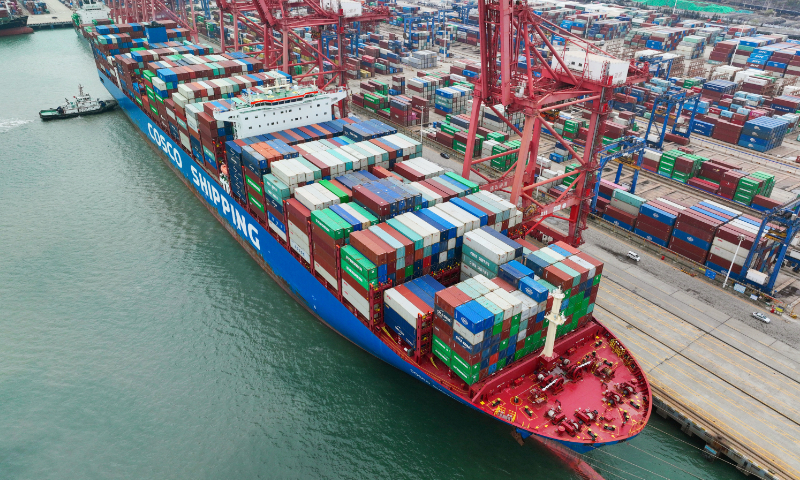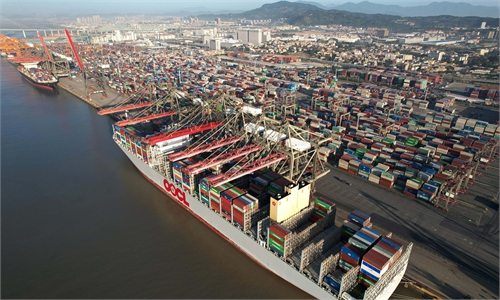China's Nov exports beat forecast with first growth in 7 months, as recovery consolidates

Large container ship Cosco Shipping Lotus docks at a terminal of Lianyungang port in Lianyungang, East China's Jiangsu Province on April 5, 2023. In the first quarter of this year, cargo throughput at Lianyungang port totaled 1.459 million standard containers, a year-on-year growth of 15.5 percent, official statistics showed. Photo: VCG
The better-than-expected data showed that China's economic recovery continues to consolidate, with more and more positive factors emerging for foreign trade as well as other aspects of the economy, Chinese officials and analysts said, adding that upcoming data will also likely point to solid growth of the Chinese economy, defying dire predictions made by some foreign politicians and institutions.
Still, the data for the first 11 months reflected a tough recovery path for China's foreign trade and lingering downward pressure for the world's second-largest economy, analysts noted. But Chinese policymakers still have plenty of policy tools and room and will likely take forceful measures to tackle risks and challenges and ensure stable economic operations going into 2024, they said.
Meanwhile, the global market attention is turning to a crucial upcoming economic meeting in China, the Central Economic Work Conference, which is usually held in mid-December. Investors will be looking closely for clues on how Chinese policymakers view China's economic conditions this year and how they set the tone for economic policies for 2024.
Beating forecast
In November, total imports and exports reached 3.7 trillion yuan ($516.68 billion), increasing 1.2 percent, with exports rising 1.7 percent and imports up 0.6 percent, the General Administration of Customs (GAC) said on Thursday.
Notably, in US dollar terms, total imports and exports in November were flat from last year, but exports expanded by 0.5 percent, the first expansion since April, according to the data. That growth pace represented a remarkable comeback from a 6.4-percent decline in October and beat a Reuters' forecast of a 1.1-percent drop.
"Entering the fourth quarter, China's foreign trade is seeing increasing positive factors, with imports and exports growing on annualized basis for two consecutive months and the stable and positive development trend continuing to consolidate," Lü Daliang, spokesperson from the General Administration of Customs, said on Thursday.
The growth for two straight months reflected the positive trend of the domestic economic recovery and a market demand rebound, according to Lü.
Analysts said that November's foreign trade data were better than expected considering lingering downward pressure from a severe and complex global situation and still weak and recovering internal demand.
"China's trade situation this year is still full of twists and turns, a bit like the letter 'N,' with a slight growth in the first quarter, a decline in the second quarter and an uptick starting in the third quarter," Gao Lingyun, a trade expert at the Chinese Academy of Social Sciences, told the Global Times on Thursday. "And November's results continued the upward trend since the third quarter, which is quite impressive."
Analysts were also encouraged by a slight expansion in imports in Chinese yuan terms in November. According to the GAC, November's imports rose by 0.6 percent to 1.6 trillion yuan.
"Imports maintained growth both this month and last month, which is quite positive, as it shows that internal demand is improving, and that might be even better than growth in exports," Tian Yun, a Beijing-based economist, told the Global Times on Thursday, noting internal demand is crucial for driving economic growth.
Tian said that while positive factors, including the structural upgrade, continue to emerge for China's trade sector, it remains relatively difficult when it comes to growth in volume.
Data also point to lingering challenges for China's overall trade. In the first 11 months of 2023, total imports and exports remained flat from last year, with exports up 0.3 percent and imports falling 0.5 percent. And, In US dollar terms, total imports and exports fell by 5.6 percent, according to the GAC.
There were also some highlights that suggest structural improvements in China's foreign trade. Notably, imports and exports with countries participating in the Belt and Road Initiative expanded by 2.6 percent in January-November, with exports to those countries jumping 6.9 percent. Also significantly, imports and exports of private enterprises increased by 6.1 percent, accounting for 53.3 percent of China's total imports and exports. Exports of smartphones grew 3.3 percent, while auto exports jumped 79.6 percent.
Improving outlook
The emerging positive factors also reflect an improving outlook for China's exports and overall economic recovery, analysts said.
"From another perspective, I think [the trade data] also point to China's overall economic recovery trend of stabilizing and improving," Gao said, adding that December's data could see further improvement. "More importantly, it will show an improvement in confidence that will effectively refute certain institutions and individuals with ulterior motives."
Some foreign institutions have been relentlessly smearing the Chinese economy. In one of the latest examples, US ratings agency Moody's on Tuesday cut its outlook on China's government credit ratings, in what Chinese analysts called a biased and unprofessional move.
While downward pressure remains, the Chinese economy continues to show remarkable resilience and its recovery will further be consolidated, with more forceful policy measures expected at the end of the year and early next year, analysts said.
"I think we are likely at an inflection point where we are entering a new cycle of economic expansion," Tian said, adding he believes that a 5-percent growth rate is likely to be pursued next year, in which more proactive fiscal arrangement is crucial. More forceful and effective policies can be expected following the Central Economic Work Conference to ensure stable growth next year, he noted.
Many global financial institutions are also increasingly upbeat on China's economic growth prospect. On Wednesday, analysts at US-based Citigroup Global Markets Inc raised their outlook on China high-grade credit to marketweight from underweight, noting China's investment-grade credit offers value and will outperform US peers in 2024, Bloomberg reported on Thursday.
China is widely expected to reach its annual growth target of around 5 percent this year, with some forecasting even higher growth rates. The IMF, for example, projected China's GDP growth to reach 5.4 percent in 2023.
For the trade sector, there are also positive factors that could ensure stable recovery, including various major trade fairs such as the China International Supply Chain Expo, which drew more than 1,100 representatives from over 90 countries, regions and international organizations, and the sixth China International Import Expo, which brought in more than 3,400 global exhibitors.


